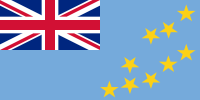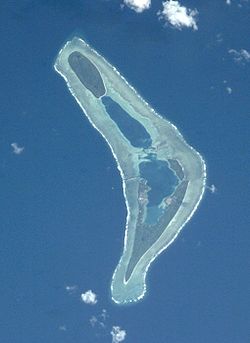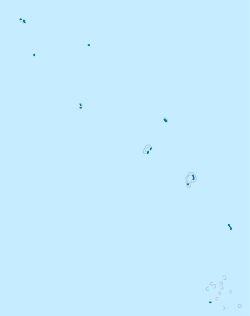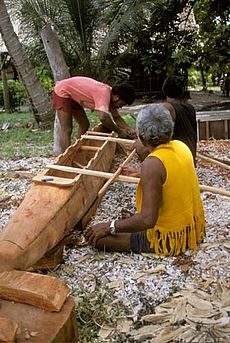- Nanumea
-
Nanumea — Atoll — Nanumea atoll from space Location in Tuvalu Coordinates: 05°41′S 176°12′E / 5.683°S 176.2°ECoordinates: 05°41′S 176°12′E / 5.683°S 176.2°E Country Tuvalu Nanumea is the northwesternmost atoll in the Polynesian nation of Tuvalu, a group of nine coral atolls and islands spread over about four hundred miles of Pacific Ocean just south of the equator and west of the International Date Line.
Contents
Geography
Located at 5°41′S 176°12′E / 5.68°S 176.20°E, along one edge of the so-called Polynesian triangle, Nanumea lies just south of the Gilbert Islands, which are Micronesian in language and culture. Nanumea is a classic atoll, a series of low islets sitting on a coral reef shelf surrounding a lagoon. About 12 km long by 2½ km wide in overall size, the dry land area is about 3.9 sq. kilometers (1.5 sq. miles). The population of 664 (2002 census) lives primarily in the main village at the northwest tip of the largest of the five islets making up the atoll, Nanumea proper. The junior school is Kaumaile Primary School. There are scattered households across the lagoon from Nanumea village at Matagi and on Motu Foliki, and on the southeastern tip of Lakena islet. The two largest islets, comprising over 90% of the dry land area of the atoll, are Nanumea and Lakena. In addition there are three much smaller islets, Motu Foliki, Lafogaki and Te Afua a Taepoa spread around the encircling reef flat.
Language & Cultural Links
Nanumeans are Polynesians. The Nanumean dialect of the Tuvaluan language is closely related to other west Polynesian languages including Tokelauan, Samoan, and the languages of the Polynesian outliers. Although the eight Tuvalu communities have distinctive accents and some distinctive vocabulary, the dialects of Tuvalu are mutually intelligible to Tuvalu speakers with the exception of the language of Nui atoll, whose inhabitants speak a dialect of the Gilbertese language (with the exception of small children, most Tuvaluans from Nui also speak Tuvaluan). With this exception, Tuvaluan is universally understood and spoken in Tuvalu. English is also spoken, especially in Tuvalu's capital, and is one of the official languages of the central government.
History
The rich mythical history of Nanumea describes settlement led by an explorer/adventurer and warrior from the south named Tefolaha. Some accounts say Tefolaha and his crew came from Tonga, others name Samoa, but whether these names refer to today's Tonga and Samoa is not certain. Tefolaha, traditional accounts say, found the island of Nanumea populated by two women, Pai and Vau, whom it was believed had formed it from baskets of sand. Tefolaha wagered with them for the island and eventually won it through trickery, whereupon Pai and Vau departed. Tefolaha's sons and daughters are today the founding ancestors of leading families and the seven chiefly lineages of Nanumea. Today's population also traces descent from crew members who arrived with Tefolaha, and from later visitors from the far distant and more recent past.
Francisco Antonio Mourelle sailed past Nanumea on 5 May 1781, giving it the name ‘San Augustin’.[1][2] In 1809 Captain Patterson in the brig Elizabeth sighted Nanumea while passing through the northern Tuvalu waters on a trading voyage from Port Jackson, Sydney, Australia to China.[3]
19th century resident Palagi traders included: Tom Day (c.1872)[4] and Jack Buckland (c.1895).
The population of Nanumea from 1860-1900 is estimated to be between 500[5] and 650 people.[6]
Governance and Connection to other Nanumean Communities
Nanumea's local government consists of a chiefly council (Fale Kaupule) representing the seven chiefly lines which trace descent from the founder, Tefolaha, or from other key settlers, and an elected high chief (Pulefenua). The island also elects and sends two representatives to the Tuvalu national parliament based in the capital, Funafuti.
While Nanumea atoll remains the homeland for all Nanumeans, there are increasingly large populations of Nanumeans resident in the capital, Funafuti, in New Zealand (especially Auckland and Wellington), and in Australia and other Pacific locations. These expatriate populations are well-organized, have active elected leadership councils, and keep in close touch with doings in Nanumea itself.
Identity
Nanumean identity and pride is demonstrated in many ways, from the distinctive intonation pattern and vocabulary of its version of Tuvaluan to celebrations including its unique Po o Tefolaha, part of a long holiday covering Christmas, New Year and some weeks beyond. These "Big Days" (Po Lahi) celebrations, marked with noon feasts in the island's community hall, the Ahiga, feature a marathon round of the competitive ball game Ano, pitting the two village sides, Haumaefa and Lolua, against each other. On January 8 each year, the island's conversion to Christianity over a century ago is commemorated in the Po o Tefolaha, "Tefolaha's Day", also called by some "Aso Pati", which stands for the letters in the Nanumean language phrase "the day of Tefolaha and Jesus." Po Lahi is celebrated in Nanumea itself and by many Nanumean communities overseas, including those in Funafuti, Auckland, Tarawa, Australia and other locations.
A widely recognized symbol of Nanumean identity and unity is the fighting spear, "Kaumaile."[7] Said to have been brought with him by the island's founder, Tefolaha, Kaumaile was used to defeat invaders to Nanumea, most notably by Lapi to defeat a giant, Tuulaapoupou. Recent carbon dating tests have shown that the Kaumaile spear is over 800 years old.[8]
Prominent local people
Maatia Toafa, Prime Minister of Tuvalu 2004–2006 represented Nanumea in the Parliament of Tuvalu.
Willy Telavi from Nanumea was appointed Home Affairs Minister in the Government of Apisai Ielemia in 2006.
Lady Naama Maheu Latasi, the first woman to be elected to the Parliament of Tuvalu, was elected from the constituency of Nanumea.
References
- ^ Keith S. Chambers & Doug Munro, The Mystery of Gran Cocal: European Discovery and Mis-Discovery in Tuvalu, 89(2) (1980) The Journal of the Polynesian Society, 167-198
- ^ Laumua Kofe, Palagi and Pastors, Tuvalu: A History, Ch. 15, (USP / Tuvalu government)
- ^ Keith S. Chambers & Doug Munro, The Mystery of Gran Cocal: European Discovery and Mis-Discovery in Tuvalu, 89(2) (1980) The Journal of the Polynesian Society, 167-198
- ^ Hayter, Lieut, Francis, Logbook & Journal, H.M.S. Basilisk, January 1871-1873, Pacific Manuscripts Bureau
- ^ Richard Bedford, Barrie Macdonald & Doug Monro, Population Estimates for Kiribati and Tuvalu (1980) 89(1) J. of the Polynesian Society 199
- ^ W.F. Newton, The Early Population of the Ellice Islands, 76(2) (1967) The Journal of the Polynesian Society, 197-204.
- ^ http://www.nanumea.net/More_about_Kaumaile.html
- ^ http://www.nanumea.net
Literature
Chambers, Keith S. and Anne 2001 Unity of Heart: Culture and Change in a Polynesian Atoll Society. Prospect Hts, Illinois: Waveland Press (ISBN 1-57766-166-4)
Chambers, Anne 1984 Nanumea. (No. 6 in Atoll Economy: Social Change in Kiribati and Tuvalu.) Canberra: Australian National University, Development Studies Centre (ISBN 86784-457-4)
Chambers, Keith S. 1984 Heirs of Tefolaha: Tradition and Social Organization in Nanumea, a Polynesian Atoll Community. Ph.D. Dissertation, Anthropology, University of California, Berkeley (pub. by University Microfilms, Ann Arbor, Michigan)
Laracy, Hugh (editor) 1983 Tuvalu: a History. Suva: University of the South Pacific, Institute of Pacific Studies and Extension Services, and Funafuti: Ministry of Social Services. [21 chapters, maps, photos, appendices. Chapters written by Tuvaluan authors]
External links
- Nanumea.Net—A Website for the People of Nanumea
- Images and further information on the Kaumaile spear from Nanumea.net
- TuvaluIslands.com
Islands and atolls of Tuvalu Islands 
Atolls Islets of Funafuti Amatuku • Avalau • Falaoigo • Fale Fatu • Fatato • Fongafale • Fuafatu • Fuagea • Fualefeke • Fualopa • Funafala • Funamanu • Luamotu • Mateika • Motugie • Motuloa • Mulitefala Nukusavalevale • Papa Elise • Pukasavilivili • Te Afuafou • Te Afualiku • Tefala • Telele • Tengasu • Tepuka • Tepuka Vili Vili • Tutanga • VasafuaIslets of Nanumea Islets of Nui Fenua Tapu • Telikiai aka Meang • Motupuakaka • Pakantou • Piliaieve • Pongalei • Talalolae • Tokinivae • UnimaiIslets of Nukufetau Faiava Lasi • Fale • Funaota • Kongo Loto Lafanga • Lafanga • Matanukulaelae • Motufetau • Motulalo • Motuloa (north of Nukufetau) • Motuloa (south of Nukufetau) • Motumua • Niualuka • Niuatui • Oua • Sakalua • Savave • Teafatule • Teafuaniua • Teafuanonu • Teafuone • TemotulotoIslets of Vaitupu Categories:- Atolls of Tuvalu
- Nanumea
Wikimedia Foundation. 2010.



